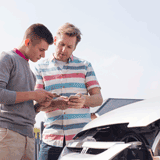News and Updates
Driving in the rain? How to avoid hydroplaning and control your vehicle
Hydroplaning (also known as aquaplaning) occurs when a layer of water comes between your car’s tires and the road, causing your car to skid or slide across a wet surface. Even for the most experienced driver, this loss of steering and braking control can be a terrifying experience with potentially disastrous consequences.
Contrary to popular belief, hydroplaning can occur even when the road you are driving on is only slightly damp. Whether you suddenly find yourself driving through a torrential downpour or travelling down a wet road after a light drizzle, your car could be at risk of hydroplaning.
How to avoid hydroplaning
1. Maintain your tires
Tires that are over- or under-inflated have a greater risk of losing traction and control than tires that are properly inflated. Check your owner’s manual for information on the optimal tire pressure for your car and adjust accordingly. Ensuring your tires are regularly rotated and balanced can also help to prevent your car from hydroplaning on wet roads. This should be done approximately every six months or 8,000 to 12,000 kilometres. Tires that are slick or bald will need to be replaced. Contact a trusted professional to discuss an appropriate maintenance schedule for your tires if you’re unsure.
2. Reduce your speed
When driving on wet roads, reduce your speed considerably. Give yourself plenty of stopping distance between you and the car ahead and refrain from any sudden acceleration or braking.
3. Turn off cruise control
As soon as it starts to rain, turn off your vehicle’s cruise control system and maintain a safe speed. If your car begins to hydroplane while cruise control is on, it will take additional time to disable the function before you can regain control.
4. Avoid puddles and standing water
If you see a pocket of collected water on the road, try to safely steer out of the way. Driving over standing water will likely result in your car hydroplaning as you attempt to drive through.
How to keep your car under control if it is hydroplaning
1. Immediately take your foot off the accelerator
Take your foot off the gas as soon as you notice your car beginning to hydroplane. Otherwise, you risk veering suddenly in the wrong direction once your car’s tires regain traction. If there is enough space between you and the car ahead, allow your car to slow safely on its own.
2. Don’t hit the brakes
Many drivers’ first reaction when they feel their car hydroplaning is to slam on the brakes. Sudden braking on a wet road could cause your car’s tires to lock and your car to skid out of control. If you do need to stop to prevent a collision and your car has an anti-lock braking system, steadily press your foot on the brake pedal without slamming it down. If your car has a regular braking system, pump the brake pedal lightly and swiftly.
3. Steady your steering wheel
Hold your car’s steering wheel firmly and keep it pointed straight ahead. Avoid jerking the steering wheel in either direction and wait to feel your car’s tires reconnect with the road.
Sometimes accidents happen to even the most experienced and careful drivers. That’s why it’s important to know that you’re covered before hitting the road. If you’d like to find out more about your current OTIP auto policy, call your OTIP broker at 1-800-267-6847. If you’d like to get a new quote for car insurance, speak with an OTIP broker today at 1-866-561-5559.
If you enjoyed reading this article, subscribe to OTIP’s e-communications and you will get more news like this delivered straight to your inbox. Plus, you will be entered for a chance to win a $500 gift card!







